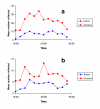Raised houses reduce mosquito bites
- PMID: 14667242
- PMCID: PMC317347
- DOI: 10.1186/1475-2875-2-45
Raised houses reduce mosquito bites
Abstract
BACKGROUND: In many parts of continental Africa house construction does not appear to impede entry of malaria vectors and, given their generally late biting cycle, the great majority of transmission takes place indoors. In contrast, many houses in São Tomé, 140 km off the coast of Gabon, are raised on stilts and built of wooden planks. Building on stilts is a time-honoured, but largely untested, way of avoiding mosquito bites. Exposure may also be affected by mosquito activity times and age composition of host-seeking females. A study was therefore undertaken on the island of São Tomé to determine if exposure to Anopheles gambiae, the only vector on the island, varied with house construction or time of the night. METHODS: A series of all-night landing collections were undertaken out of doors at ground level, inside houses at ground level, on the verandas of, and inside houses built on stilts. The gonotrophic age of an unselected sample of insects from the first three hours of landing collection (18:00-21:00) was determined by dissection. In addition, 1,149 miniature light-trap collections were obtained from 125 houses in the study area. Numbers collected were related to house construction. RESULTS: Biting of An. gambiae took place primarily outside at ground level. Less than one third of biting occurred inside houses. Houses built on stilts had half the number of An. gambiae in them compared to those built at ground level. Conversely houses with an eaves gap had more An. gambiae in them than houses without such a gap. Gonotrophic age did not affect house entry rates in An. gambiae. House construction affected Culex quinquefasciatus less than An. gambiae. Mean density per house, derived from a series of 1,490 randomly assigned light-trap collections, was over-dispersed with 18% of houses having 70% of the vectors. CONCLUSION: House construction plays an important role in determining exposure to malaria vectors in São Tomé. Neighbours can have very different exposure levels. Recommendations for improvement in control are given.
Figures



References
-
- Gillies MT, De Meillon B. The Anophelinae of Africa South of the Sahara. Publication No 54 South African Institute for Medical Research, Johannesburg. 1968.
-
- Gamage-Mendis AC, Carter R, Mendis C, de Zoysa APK, Herath PRJ, Mendis KN. Clustering of malaria infections within an endemic population: risk of malaria associated with the type of housing construction. Am J Trop Med Hyg. 1991;45:77–85. - PubMed
-
- Herodotus . In: The histories. A de Sélincourt, editor. Penguin Books, London; 1966.
LinkOut - more resources
Full Text Sources
Miscellaneous

